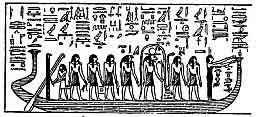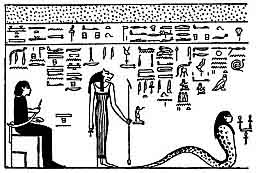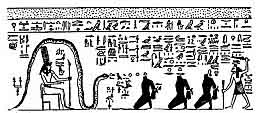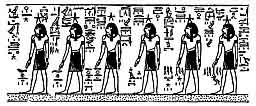
The Boat of Af, the dead Sun-god, in the Seventh Hour.
THE scene that illustrates the SEVENTH DIVISION of the Tuat, which is passed through by the Sun-god during the SEVENTH HOUR of the Right, is introduced by three lines of text, which read:--
"The Majesty of this great god taketh up his abode in the Hall of Osiris, and the Majesty of this god
addresseth words to the Hall of the gods who dwell therein. This god performeth all the rites proper [for entering] this Hall, and he advanceth on his way against Apep by means of the words of power of Isis, and by means of the words of power of the Sovereign God. The name of the gate of this City wherethrough passeth this god is RUTI-ASAR. The name of this City is THEPHET-SHETA. The name of the hour of the night which guideth this great god into it is KHEFTES-HAU-HESQET-[NEHA]-HRA."

The Boat of Af, the dead Sun-god, in the Seventh Hour.
In the middle register are:--
1. The boat of Ra, who stands under a canopy formed by the body of the serpent MEHEN; the god is ram-headed and wears a disk on his head, and his name AFU is written twice near him. In front of him stand HEKA-SER and SA, and ISIS, who has both arms stretched out before her, and is reciting the words of power which shall make the boat to advance.
Behind the god stand HERU-HEKEN, KA-SHU, NEHES, HU, and the "protector of the boat." Above the boat is written:--"This great god journeyeth in this City in the path of the Circle of SAR (Osiris) by means of the utterances of the words of power of Isis and of the words of power of SER, so that he may journey on his way against NEHA-HRA. If these words of power of Isis, and those of SER be uttered, APEP shall be turned back and shall be shut up in Ament, in the hidden place of the Tuat; if they be uttered on the earth it shall be so likewise. Whosoever shall utter them shall become one of those who are in the boat of Ra, both in heaven and upon earth; but whosoever knoweth not these figures shall not know how to repulse NEHA-HRA."
2. The serpent NEHA-HRA, which is transfixed to the ground by means of six knives. The goddess SERQET stands with a band round his neck in the act of
strangling him, and the god HER-TESU-F stands by his tail, round which he is tying a fetter. The text which refers to him reads:

The serpent Neha-hra being fettered by Serqet and Her-tesu-f.
"He who is in this picture is Apep, and he surroundeth his country, which is in the Tuat; TCHAU is the name of this district, which is four hundred and forty cubits
in length, and four hundred and forty cubits in breadth, and his voice guideth the gods to him. He who is with (?) him after this great god hath made his passage through this City, halteth (?) with AFU, opposite to the country whereover he would make a way; behold, SERQET is at the head [of Apep], and HER-TESU-F placeth his deadly fetter about his feet after Isis hath taken possession of the words of power of SER of two-fold strength, [and Ra] giveth their it words of power. Whosoever knoweth it (i.e., this picture and the text) upon earth shall not be one of those of whose water NEHA-HRA drinketh."

Temtith. Tenith. Nakith. Hetemtit.
3. The goddess HETEMTIT, armed with a knife.
4. The goddess NAKITH, armed with a knife.
5. The goddess TENIT, armed with a knife.
6. The goddess TEMTITH, armed with a knife. These four goddesses
guard four rectangular coffers, at the end of each of which is a human head; inside each coffer is a mound of sand, beneath which is buried one of the four forms of Osiris. The first coffer "contains the form of TEM," the second "contains the form of "KHEPERA," the third "contains the

(Left) The coffer of Tem. (Right) The coffer of Khepera.

(Left) The coffer of RA. (Right) The coffer of Osiris.
form of Ra," and the fourth "contains the form of OSIRIS." The goddesses are described as:
[paragraph continues] "The goddesses who hack at Apep in the Tuat, who repulse (or, bring to nought) the affairs (or, matters) of the enemies of Ra. Those who are in this picture, and who hold knives, hack asunder Apep in the Tuat each day."
7-10. The four coffers of Osiris, concerning which it is said: "[These are the] hidden magical figures of the Tuat, the funeral shrines of the hidden heads. [When] those who reached this region [come there, the hidden heads] appear, [and when they have heard the voice of RA] they eat their own forms, after this great god hath passed them by." The line of hieroglyphics above the upper register reads:
[paragraph continues] "The hidden road of Ament. The great god maketh his way over it in his holy boat, and he passeth over this road which has no water, and none to tow. He maketh his way by means of

(Left) Neb-Uast. (Right) Seth-ab (?).
the words of power of Isis, and by means of the words of power of SEMSU (?), and the utterances of this great god himself [act as] magical protectors, and perform the slaughters of APEP in the Tuat, in this Circle in his windings in the sky. Whosoever shall make [a copy of] these [pictures] according to the similitudes which are in writing at the northern side of the hidden palace in the Tuat they shall act for him that maketh them as magical protectors in heaven and in earth. Whosoever knoweth them shall be as the SPIRITS with Ra."
11. The god NEB-UAST, standing, and holding a sceptre in his right hand.
12. The goddess SETH-AB (?).
In the upper register are:--
1. The god SHEPES, in mummied form, seated,

(Left) Shepes. (Center) Ath. (Right) Ankhuithit.
and holding in his right hand some curved object, which resembles a boomerang.
2. The goddess ATH, with the head of a lioness, holding the symbol of "life" in her right hand, and a sceptre in her left.
3. The uraeus ANKHUITHIT, with the head of a woman.
4. A god in human form, seated on a throne, wearing plumes and an uraeus on his head, with "life" in his right hand, and the sceptre in his left; this god is called AFU-ASAR, and he is seated under a canopy which is formed by the body of a monster serpent called ANKH-ARU-TCHEFAU-ANKH-ARU. The text which refers to the first three gods reads: "The Majesty of this great and holy god saith, Grant thou me to come forth on the path by thy spittle(?) and by [thy] throat and let me utter the word which is maat to Ankhit, and let me open thy fold, for I have come to illumine the darkness, and to embrace him that is in Mehen." The text which refers to AFU-ASAR reads:
[paragraph continues] "This god saith unto Osiris, who dwelleth in the serpent MEHEN, Hail, Osiris, Governor of the Tuat, thou lord of life, thou ruler of Amentet, thou shalt live, live thou life, thou hast magical power, and shalt prevail by magical

(Left) Afu-Asar under the serpent Mehen. (Right) The beheading of the enemies of Osiris.
power in [this] land. Thou dost exalt those who are in thy following on their arrival before thee. Thine enemies are beneath thy feet, thou hast gained the mastery over those who have worked against thee. The flames [of fire] are against them, he burneth them up with his blazing knife which is over them, he hacketh them in pieces and choppeth them up with his slaughtering knife, and he reckoneth up his members each day. O let me pass over thee in peace."
5. Three headless figures, kneeling, with their arms tied behind their backs; these represent the enemies of Osiris. Behind these stands a fierce cat-headed (or, lynx-headed) god, who holds a huge pointed stake in one hand, and flourishes a large knife in the other.
6. Three foes of Osiris lying on their backs; round the right arm of each a rope is tied, and the other ends of the three ropes are in the hands of a god called ANKU. The passage which refers to these reads:

Anku fettering the foes of Osiris.

(Left) Sa-Tathenen. (Right) The serpent Afu-Tem.

Divine Souls of the Seventh Hour.
[paragraph continues] "The Majesty of this god saith:--O ye spirits who are hostile to Osiris, who have rebelled against the Governor of the Tuat, your hands and arms are fettered, and [ye] are tied tightly with bonds, and your souls are kept under ward, and your shades are hacked in pieces, ANKU hath drawn the cords about you so tightly that ye shall never be able to escape from his restraint."
7. Three bearded, human-faced hawks, wearing on their heads the double crown of the South and North; the first is called SA-TATHENEN, the name of the second is wanting, and the third is called MAM (?), or MAAT.
8. A huge serpent, which bears on its back a god in a sitting posture; the god is called AFU-TEM, and the remains of the text which refers to him say that he shoots forth his flame at those who rebel against Osiris, and that he eats the souls of the enemies of the god.
In the lower register are:--
1. The god HERU-HER-KHENT-F, seated on a throne, as his name implies. He is hawk-headed, and wears the solar disk encircled by a serpent; in his right hand is the symbol of life, and in his left a sceptre. The other forms of his name are ### and ###. Of this god it is said: "The work of this figure who is in this picture is in the Tuat, and it is for him to send the stars on their way, and to make the hours to go on their way in the Tuat." The stars are personified by gods, twelve in number, who stand each with a star on his head. Their names are:--
1. UR-KERT.
2. KEKHERT (?).
3. NEB-KHERT-TA.
4. TUATI.
5. HIAT.
6. HI-KHU-. . . ..
7. EMTA-A.

Ur-kert. Kekhert. Neb-khert-ta. Tuati. Hiat. Hi-khu-. . . .

Emta-a. Teser-a. Emma-a. Sem-nes-f. Tesem-em-maat-f. Seqer-tepu.
8. TESER-A.
9. EMMA-A.
10. SEM-NES-F.
11. TESEM-EM-MAAT-F.
12. SEQER-TEPU.
The text relating to these gods reads: "The Majesty of Horus of the Tuat saith unto the starry gods:--O ye who are maat in your flesh, whose magical powers have come into being for you, who are united unto your stars and who yourselves rise up for Ra in the horizon which is in the Tuat each day, O be ye in his following, and let your stars guide his two hands so that he may journey through the Beautiful Ament in peace. And, O ye gods who stand up, who dwell in our land, light up ye your stars in the sky so that [I] may unite [myself] with the master of the horizon."
2. The Twelve Goddesses of the Hours, who face to
the right, having each a star on her head. Their names are:--
1. HEKENNUTHETH.
2. NEBT-EN-. . . .
3. NEBT-NEBT.
4. TUATHETH.
5. AMENTET-ERMEN.
6. [Name erased.]
7. ANITH.
8. AUNITH.
9. TAIT.
10. ARIT-KHU.
11. ARIT-ARU.
12. UAAT-TESTES.
The text relating to the goddesses of the hours reads:
"The Majesty of Heru-Tuati
saith unto the Hours who are in this City:--O ye Hours who have the power of coming into being, O ye Hours who are endowed with stars, O ye Hours who avenge Ra, fight ye on behalf of Him that is on the horizon, and take ye your forms (or, attributes), and carry ye your symbols, and lift ye up your heads and guide this [god] Ra, who is on the horizon, into the beautiful Amentet in peace." The text goes on to say:
"Behold the gods and goddesses who guide this great god along the hidden way of this City."
3. In front of the Hours is an enormous crocodile called AB-SHA-AM-TUAT, which is described as "Osiris, the Eye of Ra." The crocodile stands upon a long funeral
mound, out of the end of which, immediately under the head of the animal, appears a bearded human head, i.e., "the head of Osiris." Of the crocodile the text says: "He who is in this picture is AB-SHAU, and he is the warden of the symbols of this city. When he heareth the voice [of the boat of] Ra which is addressed to the Eye which is in his cheek (?), the head which is in his dominion maketh its appearance, and then it eateth its own form after this great god hath passed it by. Whosoever knoweth this [picture] AB-SHAU shall not devour his soul."
Next: Chapter VIII. The Eighth Division of the Tuat, Which Is Called Tebat-Neteru-s